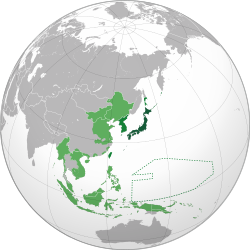The Empire of Japan
| Empire of Japan | |||||
|
Dai Nippon Teikoku |
|||||
|
|||||
|
Motto 五箇条の御誓文 "Charter Oath" ("The Oath in Five Articles") in Meiji era 八紘一宇 "Hakkō ichiu" ("The World Under One Roof") or ("All Eight Corners of the World") in Showa era |
|||||
Anthem
|
|||||
|
The Empire of Japan in 1942
|
|||||
| Capital | Tokyo | ||||
| Languages | Japanese | ||||
| Religion | De jure: none De facto: State Shinto Other: Buddhism |
||||
| Government |
Daijō-kan (1868–1885) Constitutional monarchy (1890–1940, 1945-1947) One-party totalitarian military dictatorship under the Emperor (1940–1945) Supreme Commander for the Allies (1945-1947) |
||||
| Emperor | |||||
| • | 1868–1912 | Meiji | |||
| • | 1912–1926 | Taishō | |||
| • | 1926–1947 | Shōwa (Hirohito) | |||
| Prime Minister | |||||
| • | 1885–1888 | Itō Hirobumi | |||
| • | 1946–1947 | Shigeru Yoshida | |||
| Legislature | Imperial Diet | ||||
| • | Upper house | House of Peers | |||
| • | Lower house | House of Representatives | |||
| Historical era | Meiji, Taishō, Shōwa | ||||
| • | Meiji Restoration | January 3, 1868 | |||
| • | Constitution adopted | November 29, 1890 | |||
| • | First Sino-Japanese War | July 25, 1894 | |||
| • | Russo-Japanese War | February 10, 1904 | |||
| • | Second Sino-Japanese War and Pacific War | September 18, 1931 | |||
| • | Surrender of Japan | September 2, 1945 | |||
| • | Reconstituted | May 2, 1947 | |||
| Area | |||||
| • | 1938 | 1,984,000 km2 (766,000 sq mi) | |||
| Population | |||||
| • | 1920 est. | 77,700,000a | |||
| • | 1940 est. | 105,200,000b | |||
| Currency |
Japanese yen, Korean yen, Taiwanese yen, Japanese military yen |
||||
| a. | 56.0 million lived in Japan proper. | ||||
| b. | 73.1 million lived in Japan proper. | ||||
| Empire of Japan | |
| Official Term name | |
|---|---|
| Official Term | Empire of Japan |
| Literal Translation name | |
| Literal Translation | Greater Japanese Empire |
Other: Buddhism
The Empire of Japan (大日本帝國 Dai Nippon Teikoku, literally "Greater Japanese Empire") was the historical Japanese nation-state and great power that existed from the Meiji Restoration in 1868 to the enactment of the 1947 constitution of modern Japan.
Imperial Japan's rapid industrialization and militarization under the slogan Fukoku Kyōhei (富國強兵, "Enrich the Country, Strengthen the Armed Forces") led to its emergence as a world power and the establishment of a colonial empire. Economic and political turmoil in the 1920s led to the rise of militarism, eventually culminating in Japan's membership in the Axis alliance and the conquest of a large part of the Asia-Pacific region. Imperialist Japan was the Axis power that started World War II in Asia in 1937 with China, and in 1941 with the United States, causing great devastation throughout much of Asia.
Imperial Japan's armed forces initially had large-scale invasions acted-out during the Second Sino-Japanese War (1937–1945) and the Pacific of World War II. However, after suffering many defeats from the United States and Allied Powers before and following the Soviet Union's declaration of war against Japan and invasion of Manchuria, and the atomic bombings of Hiroshima and Nagasaki , Japan surrendered to the Allies on August 15, 1945. A period of occupation by the Allies followed the surrender, and a new constitution was created with American involvement in 1947, officially ending the Empire. Occupation and reconstruction continued well into the 1950s, eventually forming the current nation-state whose full title is the "State of Japan" or simply rendered "Japan" in English.
...
Wikipedia



